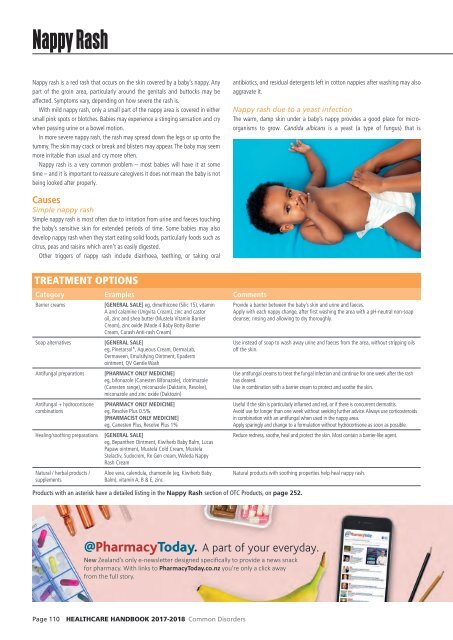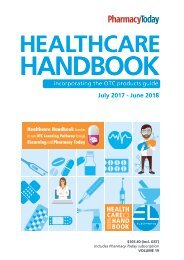2017 HCHB_digital
Create successful ePaper yourself
Turn your PDF publications into a flip-book with our unique Google optimized e-Paper software.
Nappy Rash<br />
Nappy rash is a red rash that occurs on the skin covered by a baby’s nappy. Any<br />
part of the groin area, particularly around the genitals and buttocks may be<br />
affected. Symptoms vary, depending on how severe the rash is.<br />
With mild nappy rash, only a small part of the nappy area is covered in either<br />
small pink spots or blotches. Babies may experience a stinging sensation and cry<br />
when passing urine or a bowel motion.<br />
In more severe nappy rash, the rash may spread down the legs or up onto the<br />
tummy. The skin may crack or break and blisters may appear. The baby may seem<br />
more irritable than usual and cry more often.<br />
Nappy rash is a very common problem – most babies will have it at some<br />
time – and it is important to reassure caregivers it does not mean the baby is not<br />
being looked after properly.<br />
antibiotics, and residual detergents left in cotton nappies after washing may also<br />
aggravate it.<br />
Nappy rash due to a yeast infection<br />
The warm, damp skin under a baby’s nappy provides a good place for microorganisms<br />
to grow. Candida albicans is a yeast (a type of fungus) that is<br />
Causes<br />
Simple nappy rash<br />
Simple nappy rash is most often due to irritation from urine and faeces touching<br />
the baby’s sensitive skin for extended periods of time. Some babies may also<br />
develop nappy rash when they start eating solid foods, particularly foods such as<br />
citrus, peas and raisins which aren’t as easily digested.<br />
Other triggers of nappy rash include diarrhoea, teething, or taking oral<br />
TREATMENT OPTIONS<br />
Category Examples Comments<br />
Barrier creams<br />
Soap alternatives<br />
Antifungal preparations<br />
Antifungal + hydrocortisone<br />
combinations<br />
Healing/soothing preparations<br />
Natural / herbal products /<br />
supplements<br />
[GENERAL SALE] eg, dimethicone (Silic 15), vitamin<br />
A and calamine (Ungvita Cream), zinc and castor<br />
oil, zinc and shea butter (Mustela Vitamin Barrier<br />
Cream), zinc oxide (Made 4 Baby Botty Barrier<br />
Cream, Curash Anti-rash Cream)<br />
[GENERAL SALE]<br />
eg, Pinetarsol*, Aqueous Cream, DermaLab,<br />
Dermaveen, Emulsifying Ointment, Epaderm<br />
ointment, QV Gentle Wash<br />
[PHARMACY ONLY MEDICINE]<br />
eg, bifonazole (Canesten Bifonazole), clotrimazole<br />
(Canesten range), miconazole (Daktarin, Resolve),<br />
miconazole and zinc oxide (Daktozin)<br />
[PHARMACY ONLY MEDICINE]<br />
eg, Resolve Plus 0.5%<br />
[PHARMACIST ONLY MEDICINE]<br />
eg, Canesten Plus, Resolve Plus 1%<br />
[GENERAL SALE]<br />
eg, Bepanthen Ointment, Kiwiherb Baby Balm, Lucas<br />
Papaw ointment, Mustela Cold Cream, Mustela<br />
Stelactiv, Sudocrem, Re Gen cream, Weleda Nappy<br />
Rash Cream<br />
Aloe vera, calendula, chamomile (eg, Kiwiherb Baby<br />
Balm), vitamin A, B & E, zinc<br />
Products with an asterisk have a detailed listing in the Nappy Rash section of OTC Products, on page 252.<br />
Provide a barrier between the baby’s skin and urine and faeces.<br />
Apply with each nappy change, after first washing the area with a pH-neutral non-soap<br />
cleanser, rinsing and allowing to dry thoroughly.<br />
Use instead of soap to wash away urine and faeces from the area, without stripping oils<br />
off the skin.<br />
Use antifungal creams to treat the fungal infection and continue for one week after the rash<br />
has cleared.<br />
Use in combination with a barrier cream to protect and soothe the skin.<br />
Useful if the skin is particularly inflamed and red, or if there is concurrent dermatitis.<br />
Avoid use for longer than one week without seeking further advice. Always use corticosteroids<br />
in combination with an antifungal when used in the nappy area.<br />
Apply sparingly and change to a formulation without hydrocortisone as soon as possible.<br />
Reduce redness, soothe, heal and protect the skin. Most contain a barrier-like agent.<br />
Natural products with soothing properties help heal nappy rash.<br />
@PharmacyToday. A part of your everyday.<br />
New Zealand’s only e-newsletter designed specifically to provide a news snack<br />
for pharmacy. With links to PharmacyToday.co.nz you’re only a click away<br />
from the full story.<br />
Page 110 HEALTHCARE HANDBOOK <strong>2017</strong>-2018 Common Disorders



